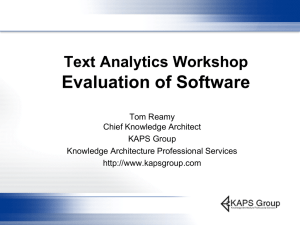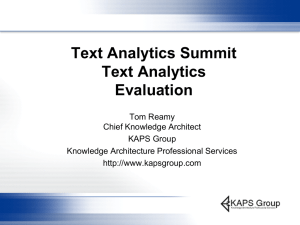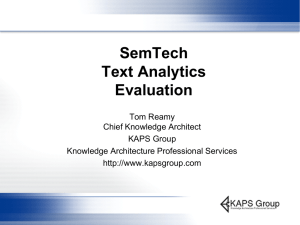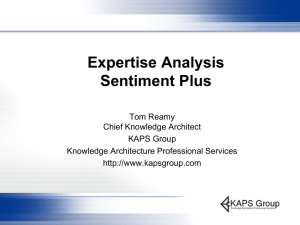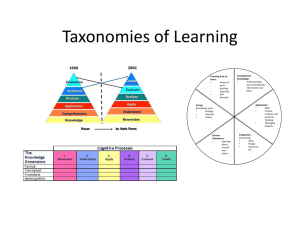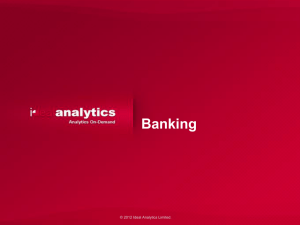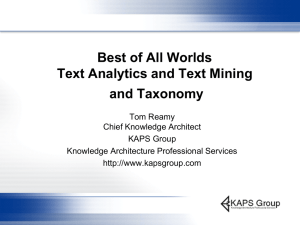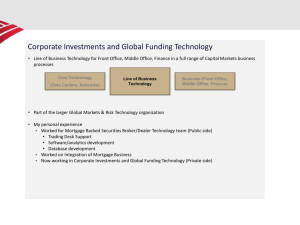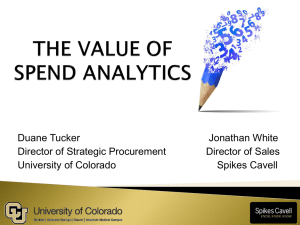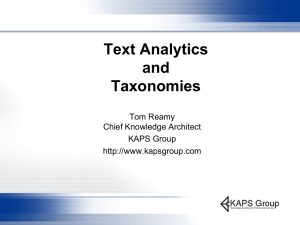Enterprise Search / Text Analytics Evaluation
advertisement
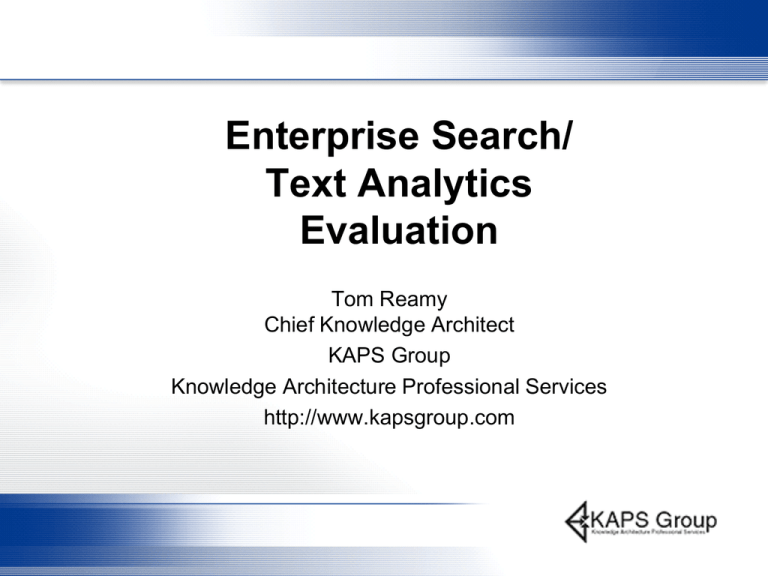
Enterprise Search/ Text Analytics Evaluation Tom Reamy Chief Knowledge Architect KAPS Group Knowledge Architecture Professional Services http://www.kapsgroup.com Agenda – Part II Introduction – Text Analytics Can Rescue Search – Elements of Text Analytics Evaluating Text Analytics Software – Varieties of Software – platform and embedded Three Phase Process / Two Examples – – – Initial Evaluation – 4 vendors Demo’s – from 4 to 2 4-6 week POC – 2 vendors Conclusions 2 KAPS Group: General Knowledge Architecture Professional Services Virtual Company: Network of consultants – 8-10 Partners – SAS, SAP, FAST, Smart Logic, Concept Searching, etc. Consulting, Strategy, Knowledge architecture audit Services: – Taxonomy/Text Analytics development, consulting, customization – Technology Consulting – Search, CMS, Portals, etc. – Evaluation of Enterprise Search, Text Analytics – Metadata standards and implementation – Knowledge Management: Collaboration, Expertise, e-learning – Applied Theory – Faceted taxonomies, complexity theory, natural categories 3 Introduction Text Analytics to the Rescue Enterprise Search is Dead! Taxonomy is Dead! Long Live Text Analytics! ECM and ES failed because search is about semantics / meaning not technology Taxonomy failed because it is too rigid, and too dumb Metadata failed because it is too hard to do for authors (not really) They all failed because Search is a semantic infrastructure element not a project 4 Introduction to Text Analytics Text Analytics Features Noun Phrase Extraction – Catalogs with variants, rule based dynamic – Multiple types, custom classes – entities, concepts, events – Feeds facets Summarization – Customizable rules, map to different content Fact Extraction Relationships of entities – people-organizations-activities – Ontologies – triples, RDF, etc. – Sentiment Analysis – Rules – Objects and phrases 5 Introduction to Text Analytics Text Analytics Features Auto-categorization Training sets – Bayesian, Vector space – Terms – literal strings, stemming, dictionary of related terms – Rules – simple – position in text (Title, body, url) – Semantic Network – Predefined relationships, sets of rules – Boolean– Full search syntax – AND, OR, NOT – Advanced – NEAR (#), PARAGRAPH, SENTENCE This is the most difficult to develop Build on a Taxonomy Combine with Extraction – If any of list of entities and other words – 6 7 8 9 10 11 Varieties of Taxonomy/ Text Analytics Software Taxonomy Management – Synaptica, SchemaLogic Full Platform – SAS-Teragram, SAP-Inxight, Clear Forest, Smart Logic, Data Harmony, Concept Searching, Expert System, IBM, GATE Content Management – Nstein, Interwoven, Documentum, etc. Embedded – Search – FAST, Autonomy, Endeca, Exalead, etc. Specialty – Sentiment Analysis - Lexalytics 12 Evaluation Process & Methodology Start with Self Knowledge – Think Big, Start Small, Scale Fast Eliminate the unfit – Filter One- Ask Experts - reputation, research – Gartner, etc. • Market strength of vendor, platforms, etc. • Feature scorecard – minimum, must have, filter to top 3-6 – – Filter Two – Technology Filter – match to your overall scope and capabilities – Filter not a focus Filter Three – In-Depth Demo – 3-6 vendors • Beyond “Yes, we have that feature.” Deep POC (2) – advanced, integration, semantics Focus on working relationship with vendor. 13 Evaluation Process & Methodology Initial Evaluation - Basic Requirements Platform – range of capabilities – Categorization, Sentiment analysis, etc. Technical – Search evaluation + Integration – – – API’s, Java based, Linux run time Scalability – millions of documents a day Import-Export – XML, RDF Usability Multiple Language Support 14 Evaluating Text Analytics Software Initial Evaluation: Usability Ease of use – copy, paste, rename, merge, etc. User Documentation, user manuals, on-line help, training and tutorials Visualization – file structure, tree, Hierarchy and alphabetical Automatic Taxonomy/Node & Rule Generation – Nonsense for Taxonomy – Node – suggestions for sub-categories, rules Variety of node relationships – child-parent, related 15 Initial Evaluation Example Outcomes Filter One: – – – – – Company A, B – sentiment analysis focus, weak categorization Company C – Lack of full suite of text analytics Company D – business concerns, support Open Source – license issues Ontology Vendors – missing categorization capabilities 4 Demos – – – Saw a variety of different approaches, but Company X – lacking sentiment analysis, require 2 vendors Company Y – lack of language support, development cost 16 Evaluating Taxonomy Software Proof Of Concept - POC Quality of results is the essential factor 4-6 weeks POC – bake off / or short pilot Real life scenarios, categorization with your content Preparation: – Preliminary analysis of content and users information needs – Set up software in lab – relatively easy – Train taxonomist(s) on software(s) – Develop taxonomy if none available 4-6 week POC – 2-3 rounds of development, test, refine / Not OOB Need SME’s as test evaluators – also to do an initial categorization of content 17 Evaluating Taxonomy Software POC Majority of time is on auto-categorization Need to balance uniformity of results with vendor unique capabilities – have to determine at POC time Risks – getting software installed and working, getting the right content, initial categorization of content Elements: – Content – Search terms / search scenarios – Training sets – Test sets of content Taxonomy Developers – expert consultants plus internal taxonomists 18 Evaluating Taxonomy Software POC Feature Test Cases Auto-categorization to existing taxonomy – variety of content Clustering – automatic node generation Summarization Entity extraction – build a number of catalogs – People, products, etc. Sentiment Analysis – products and categorization rules Evaluate usability in action by taxonomists Question – Integration with Ontologies? Technical / integration – Output in XML- API’s Map above to Client use cases 19 POC Design Discussion: Evaluation Criteria Basic Test Design – categorize test set – – – Score – by file name, human testers Accuracy Level – 80-90% Effort Level per accuracy level Sentiment Analysis – – Accuracy Level – 80-90% Effort Level per accuracy level Quantify development time – main elements Comparison of two vendors – how score? – Combination of scores and report 20 Evaluating Taxonomy Software POC - Issues Quality of content Quality of initial human categorization Normalize among different test evaluators Quality of taxonomists – experience with text analytics software and/or experience with content and information needs and behaviors Quality of taxonomy General issues – structure (too flat or too deep) – Overlapping categories – Differences in use – browse, index, categorize – Foundation for Development 21 Text Analytics Evaluation Context Dependent – Tale of Two POC’s Taxonomy GAO – flat, not very orthogonal, political concerns • Department centric, subject – Company A– flat, two taxonomies, technical - open to change? • Action oriented, activities and events – Content GAO – giant 200 page PDF formal documents, variety • Start_200, Title – Company A – short cryptic customer support notes, Social Media • Creative spelling, combination of formal and individual – Culture / Applications GAO - Formal Federal – big applications, infrastructure – Company A – informal, technical, lots of small apps – 22 Text Analytics Evaluation - Conclusions Text Analytics with Search and ECM can finally deliver the promise Search / Text analytics is not like other software – meaning Only way to deal with meaning is in context – your context – Technical issues are filters not features Enterprise Text Analytics (Platform) is best – If have to start with one application, plan for the platform POC seems expensive, but is cheaper than making a dead end choice – It is also the foundation and head start on development 23 Questions? Tom Reamy tomr@kapsgroup.com KAPS Group Knowledge Architecture Professional Services http://www.kapsgroup.com
